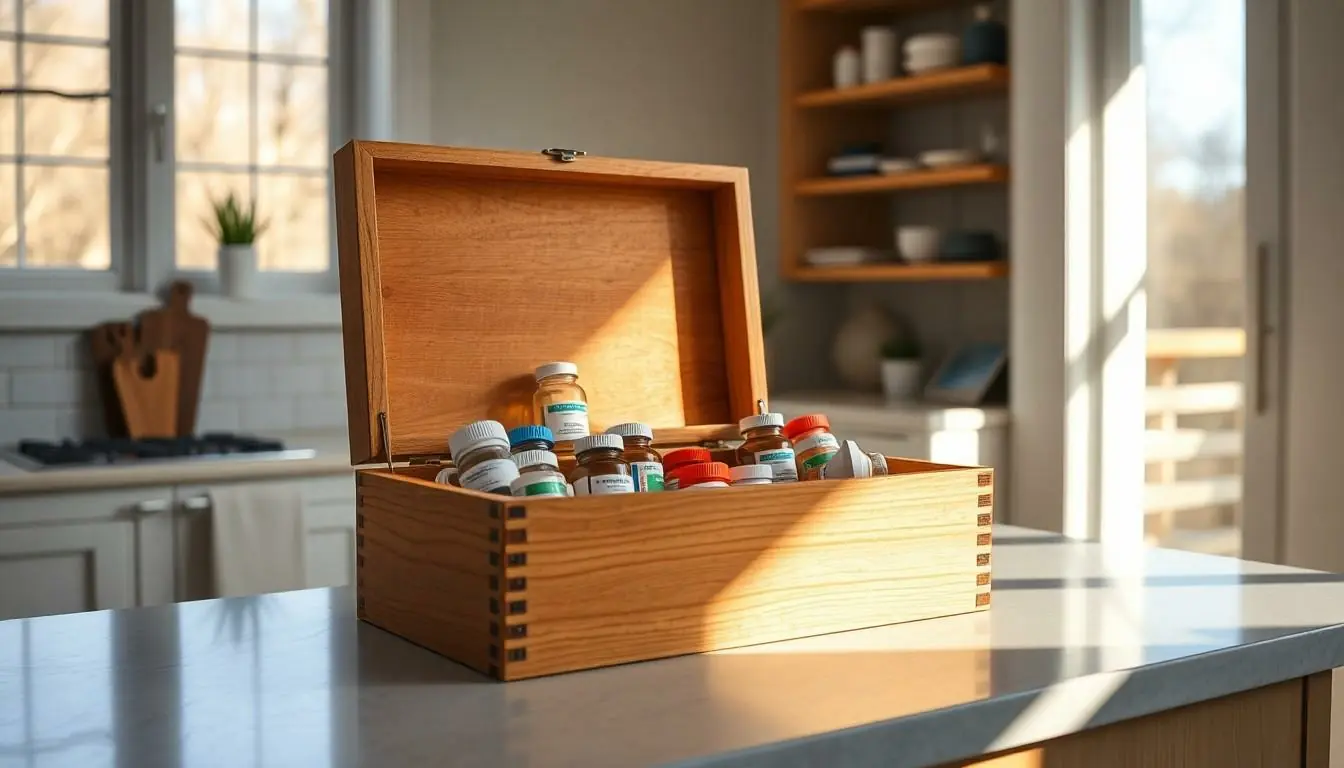In a world where finding your keys feels like a scavenger hunt, why should locating your medicine be any different? Enter the medicine storage box—a superhero in disguise, ready to rescue you from the chaos of cluttered cabinets and rogue pill bottles. This isn’t just any box; it’s a stylish solution that keeps your health essentials organized, accessible, and safe from the curious hands of little ones or nosy pets.
Table of Contents
ToggleOverview of Medicine Storage Boxes
Medicine storage boxes serve as vital tools for organizing health essentials, enhancing safety, and providing easy access. They tackle medication clutter and ensure that families can manage their supplies effectively.
Purpose and Benefits
Medicine storage boxes centralize prescriptions and over-the-counter medications. They aid in preventing accidental ingestion by children or pets, promoting safety. Also, they facilitate compliance with medication schedules, as users can find their pills quickly. Compact models fit in drawers or cabinets, while larger versions improve visibility and accessibility. Durability ensures that boxes protect contents from damage, moisture, and light, keeping medications effective.
Key Features to Consider
Materials play a crucial role in medicine storage box selection. Plastic or metal options offer different benefits in terms of durability and weight. Consider compartments for organizing medications by type or schedule. Labels enhance visibility for quicker identification of contents. Lockable features add an extra layer of security, especially in households with pets or young children. Size matters too; a box should accommodate personal inventory while remaining practical for storage.
Types of Medicine Storage Boxes

Medicine storage boxes come in various types, each tailored to specific needs and preferences. Understanding these options helps in making informed decisions.
Plastic vs. Wooden Boxes
Plastic boxes offer lightweight, durable storage, ideal for frequent use. They often include clear lids for visibility and compartments to organize medications. Wooden boxes provide a classic look and may feature intricate designs, enhancing home decor. Their sturdiness adds a sense of security. Ease of cleaning distinguishes plastic as more practical, while wooden boxes may require more maintenance. Selecting between these materials depends on personal style preferences and intended use.
Portable vs. Stationary Options
Portable medicine storage boxes cater to those requiring on-the-go access, such as travelers. These boxes often come with handles for easy transport and compact designs for convenience. Stationary options suit home environments where medications are stored in fixed locations. They generally offer more space for organizing larger inventories. Those who prefer a consistent storage solution might opt for stationary boxes, while individuals needing flexibility may lean toward portable choices. Each option plays a vital role in how medications are accessed and managed.
Tips for Organizing Your Medicine Storage Box
Organizing a medicine storage box enhances efficiency and safety. Proper categorization and labeling streamline access during emergencies or daily use.
Categorizing Medications
First, group medications by type for easy retrieval. Analgesics, antihistamines, and prescriptions can each have their own section. Sorting by frequency of use also aids in quick access; keep daily medications at the top. Consider using small containers or dividers to separate categories within the box. This method enhances visibility and prevents clutter from hindering access. Regularly review the organization system, adjusting it as needed when adding or discarding items.
Labelling Systems
Implementing a clear labeling system improves medication management. Use easy-to-read labels that identify the contents of each compartment. Consider color-coding different medication types; this visual cue simplifies locating necessary items. Labels should include expiration dates and dosage information, ensuring compliance with health guidelines. Stickers or permanent markers can offer durable solutions for labeling. Regularly update the labels when changes occur, maintaining a current and user-friendly storage system.
Safety Considerations
Safety is paramount when storing medications at home. A well-designed medicine storage box includes features that protect against accidental access, especially for children and pets.
Childproofing Features
Childproofing features play a critical role in ensuring medication safety. Lockable designs prevent unauthorized access, keeping curious hands away from potential hazards. Elevated storage locations also help to deter children from reaching the box. Some models include safety latches that require specific actions to open, making access more difficult for young ones but simple for adults. Utilizing an opaque box rather than a clear one adds an extra layer of security, as it hides contents from view, reducing temptation. These features create a safer environment for households with children or pets.
Environmental Factors
Environmental factors can impact drug efficacy and safety. Humidity, temperature, and light exposure affect medication quality. A medicine storage box should offer a controlled environment, minimizing these risks. Insulated boxes provide protection from extreme temperatures, ensuring medications remain effective over time. Additionally, selecting materials that resist moisture and direct sunlight is vital for maintaining integrity. Avoid placing the storage box in areas prone to temperature fluctuations, such as bathrooms or near windows, to enhance safety further. Maintaining optimal storage conditions extends the shelf life of medications, preventing loss of efficacy and ensuring user safety.
A medicine storage box is more than just a container; it’s a vital component of home health management. By providing a secure and organized space for medications, it enhances safety and ensures easy access for all family members. With various materials and designs available, individuals can choose options that fit their lifestyle and aesthetic preferences.
Prioritizing organization and safety within these boxes can prevent accidents and encourage proper medication adherence. Regularly updating the contents and maintaining a clear labeling system will further streamline the process. Investing in a quality medicine storage box is an essential step toward promoting a safer and healthier home environment.

